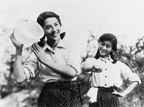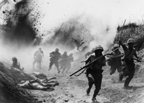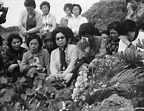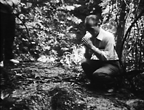Part 3
The Battle of Okinawa in Relief / A Chronicle of Memories
Described as a “Typhoon of Steel,” the Battle of Okinawa resulted in the deaths of vast numbers of local citizens. There is a Japanese historical context for the position into which Okinawans had been driven. The wartime Japanese political and military system considered the battle in Okinawa to be the final fight of the war. At the same time, America chose Okinawa as the point at which to begin its invasion of Japan. More than simply a struggle between the armies of America and Japan, the Battle of Okinawa also reveals the structural deformity of modern Japan and the complicated interplay between Japan and Okinawa. The battle shows us the problem of the military and education, the manifold structure of victim and oppressor, testimony and the shape of memory, and the darkness that resides within mankind. As we approach this darkness, the Battle of Okinawa enables us to illuminate a century of war.
| 1 | Endless Questions |
 Monument of Star Lilies
Monument of Star Lilies
(“Himeyuri no to”)- 1953 / B&W / 16mm (orig. 35mm) / 131 min / English subtitled version
Director: Imai Tadashi
Script: Mizuki Yoko
Photography: Nakao Shunichiro
Editing: Kono Akikazu
Sound: Okazaki Michio
Music: Koseki Yuji
Planning: Ito Takeo
Art Director: Kubo Kazuo
Producers: Makino Mitsuo, Okawa Hiroshi
Cast: Tsushima Keiko, Okada Eiji, Shin Kinzo, Kono Akitake, Kagawa Kyoko
Production Company: Toei
Source: The Japan Foundation
This work documents the extreme hardships endured by the Star Lily Students Corps, female students mobilized to work as nurses during the Battle of Okinawa. Film director Imai Tadashi’s numerous humanist dramas are representative of post-war Japanese cinema, and this work was acclaimed at screenings in both mainland Japan and Okinawa. Monument of Star Lilies was made when Okinawa was still under U.S. occupation, and was filmed entirely in mainland Japan. In 1982 Imai set out to remake the film on Okinawan soil.
Turbulent Showa History: Battle of Okinawa
(“Gekido no Showashi: Okinawa kessen”) 1971 / Color / 35mm / 149 min
1971 / Color / 35mm / 149 min
Director: Okamoto Kihachi
Script: Shindo Kaneto
Photography: Murai Hiroshi
Editing: Kuroiwa Yoshitami
Sound: Watarai Shin
Music: Sato Masaru
Art Director: Muraki Yoshiro
Producers: Fujimoto Masumi, Hariu Hiroshi
Cast: Kobayashi Keiju, Tanba Tetsuro, Nakadai Tatsuya, Mori Kanta, Kawazu Yusuke, Hashimoto Isao
Production Company, Source: Toho
This film depicts the specter of fighting on Okinawa, used as the stronghold for Japan’s defense during the Pacific War. Following the success of Okamoto Kihachi’s work Japan’s Longest Day (1967), movie production company Toho turned it into a series—the fourth of which was Battle of Okinawa. The film depicts struggles within the Japanese Army and offers glimpses into the suffering of Okinawans during the war, including collective suicides and the Japanese Army accusing locals of espionage, and using this as a pretext for murder.
Star Lily War History: Questioning Education and the State Today
(“Himeyuri senshi: Ima tou kokka to kyoiku”) 1979 / Color / Video / 48 min
1979 / Color / Video / 48 min
Director: Moriguchi Katsu
Photography: Mano Koichi
Editing: Hosono Kenji
Sound: Kikuta Yoshihiro, Uematsu Iwao
Narrators: Nitta Shogen, Konoshima Aiko
Producer: Ujita Hiroshi
Production Company, Source: Nippon Television Network Corporation (NTV)
Broadcast Date: May 13, 1979
TV documentary by Moriguchi Katsu, a Nippon Television Network (NTV) reporter, cameraman and director involved in the production of numerous documentary programs featuring Okinawa from the 1960s through the 1980s. An attempt to show why young girls in their mid-teens were sent off to the warfront, based on testimony from Okinawa Women Normal School and First Prefectural Girl’s High School students who were mobilized as nurses in the Star Lily Students Corps for the Battle of Okinawa frontlines.
A Gap in History: Thirty-five Years Since the Massacre of Okinawans
(“Kuhaku no senshi: Okinawa jumin gyakusatsu 35 nen”) 1980 / Color / Video / 25 min
1980 / Color / Video / 25 min
Director: Moriguchi Katsu
Photography: Kimura Akira
Editing: Nagao Masashi, Kuroda Michinori
Narrators: Ito Soichi, Konoshima Aiko
Photo Source: Ota Masahide
Producer: Mori Yasuo
Production Company, Source: NTV
Broadcast Date: November 2, 1980
An investigation of what happened during the massacre of local residents by the Japanese Army in the northern part of Okinawa’s main island during the Battle of Okinawa. Mori Sugio, who fought in the Battle of Okinawa as a communications soldier, visits Okinawa on his own to meet with the descendents of the victims and to apologize for the “crimes of the Japanese Army.” When director Moriguchi discovered that a former Japanese soldier who witnessed the massacre was still alive in Tokyo, he decided that he “must meet this person no matter what and get closer to the truth.” Answering questions in front of the camera, Mori elucidates gruesome experiences of the war.
 An Overdue Decision
An Overdue Decision
(“Ososugita seidan: Kensho/Okinawa sen e no michi”)- 1988 / Color, B&W / Video / 45 min
Research: Nakazato Masayuki
Photography: Omori Shinji
Narrator: Shinyashiki Niko
Art Director: Takashima Hikoshi
Production Company, Source: Ryukyu Broadcasting Corporation (RBC)
Why was the Battle of Okinawa fought? Could this inconceivable tragedy have been avoided if the emperor had given an early Imperial decree to end the war? This film was made by the Ryukyu Broadcasting Corporation in 1988, the year after the 42nd National Athletic Meet was held in Okinawa and the reign was on the verge of changing from Showa to Heisei. The Association for Examining the Battle of Okinawa (Tokyo), established by historians, uses the testimony of its members and the late high-ranking 32nd Army officer Colonel Yahara Hiromichi, and documents of wartime conferences between the emperor and his close associates to investigate why the tragedy of the Battle of Okinawa happened and what prolonged it.
| 2 | Voice and the Narration of Trauma: Memory and Living Words Today |
War Stories Told in Shima kutuba <Six Parts>
(“Shima kutuba de kataru ikusayu”) 2003 / shima kutuba / Color / Video / 360 min / Japanese subtitled version
2003 / shima kutuba / Color / Video / 360 min / Japanese subtitled version
Photography: Higa Toyomitsu, Murayama Tomoe
Editing: Murayama Tomoe
Production, Source: Ryukyu Islands Historical Society
Presents testimony of local experiences during the Battle of Okinawa as recounted in shima kutuba, the local dialects of the Ryukyu Islands arc. Previously released as a fifteen-minute prototype, this is the first public screening of the full version, compiling testimonies of 100 individuals. Speaking in Okinawan dialect was proscribed under Imperial assimilation policies, and was treated as an act of treason. Thus, the testimonies in shima kutuba directly confront the Battle of Okinawa on dual levels: as a generalized perversion of modernity, and as a unique historical specificity. This film portrays previously uncharted temporal and spatial territory, as the 100 personal accounts offer minute gradations of both the pain and darkness of the war era.
